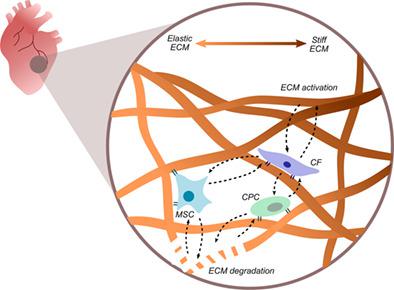当前位置:
X-MOL 学术
›
STEM CELLS
›
论文详情
Our official English website, www.x-mol.net, welcomes your
feedback! (Note: you will need to create a separate account there.)
Bidirectional relationship between cardiac extracellular matrix and cardiac cells in ischemic heart disease
STEM CELLS ( IF 4.0 ) Pub Date : 2021-09-04 , DOI: 10.1002/stem.3445 Hyun-Ji Park 1 , Kenneth J De Jesus Morales 1 , Sruti Bheri 1 , Brandon P Kassouf 1 , Michael E Davis 1, 2
STEM CELLS ( IF 4.0 ) Pub Date : 2021-09-04 , DOI: 10.1002/stem.3445 Hyun-Ji Park 1 , Kenneth J De Jesus Morales 1 , Sruti Bheri 1 , Brandon P Kassouf 1 , Michael E Davis 1, 2
Affiliation

|
Ischemic heart diseases (IHDs), including myocardial infarction and cardiomyopathies, are a leading cause of mortality and morbidity worldwide. Cardiac-derived stem and progenitor cells have shown promise as a therapeutic for IHD but are limited by poor cell survival, limited retention, and rapid washout. One mechanism to address this is to encapsulate the cells in a matrix or three-dimensional construct, so as to provide structural support and better mimic the cells' physiological microenvironment during administration. More specifically, the extracellular matrix (ECM), the native cellular support network, has been a strong candidate for this purpose. Moreover, there is a strong consensus that the ECM and its residing cells, including cardiac stem cells, have a constant interplay in response to tissue development, aging, disease progression, and repair. When externally stimulated, the cells and ECM work together to mutually maintain the local homeostasis by initially altering the ECM composition and stiffness, which in turn alters the cellular response and behavior. Given this constant interplay, understanding the mechanism of bidirectional cell-ECM interaction is essential to develop better cell implantation matrices to enhance cell engraftment and cardiac tissue repair. This review summarizes current understanding in the field, elucidating the signaling mechanisms between cardiac ECM and residing cells in response to IHD onset. Furthermore, this review highlights recent advances in native ECM-mimicking cardiac matrices as a platform for modulating cardiac cell behavior and inducing cardiac repair.
中文翻译:

缺血性心脏病心肌细胞外基质与心肌细胞的双向关系
缺血性心脏病 (IHD),包括心肌梗塞和心肌病,是全球死亡率和发病率的主要原因。心脏来源的干细胞和祖细胞已显示出作为 IHD 治疗剂的前景,但受到细胞存活率低、保留有限和快速清除的限制。解决这个问题的一种机制是将细胞封装在矩阵或三维结构中,以便在给药过程中提供结构支持并更好地模拟细胞的生理微环境。更具体地说,细胞外基质 (ECM),即原生细胞支持网络,一直是实现这一目的的有力候选者。此外,人们一致认为,ECM 及其驻留细胞(包括心脏干细胞)在响应组织发育、衰老、疾病进展、和修理。当受到外部刺激时,细胞和 ECM 一起工作,通过最初改变 ECM 的组成和刚度来相互维持局部稳态,这反过来又会改变细胞反应和行为。鉴于这种持续的相互作用,了解双向细胞-ECM 相互作用的机制对于开发更好的细胞植入基质以增强细胞植入和心脏组织修复至关重要。这篇综述总结了该领域当前的理解,阐明了心脏 ECM 和驻留细胞之间响应 IHD 发作的信号机制。此外,这篇综述重点介绍了天然 ECM 模拟心脏基质作为调节心脏细胞行为和诱导心脏修复的平台的最新进展。细胞和 ECM 一起工作,通过最初改变 ECM 的组成和刚度来相互维持局部稳态,这反过来又改变了细胞反应和行为。鉴于这种持续的相互作用,了解双向细胞-ECM 相互作用的机制对于开发更好的细胞植入基质以增强细胞植入和心脏组织修复至关重要。这篇综述总结了该领域当前的理解,阐明了心脏 ECM 和驻留细胞之间响应 IHD 发作的信号机制。此外,这篇综述重点介绍了天然 ECM 模拟心脏基质作为调节心脏细胞行为和诱导心脏修复的平台的最新进展。细胞和 ECM 一起工作,通过最初改变 ECM 的组成和刚度来相互维持局部稳态,这反过来又改变了细胞反应和行为。鉴于这种持续的相互作用,了解双向细胞-ECM 相互作用的机制对于开发更好的细胞植入基质以增强细胞植入和心脏组织修复至关重要。这篇综述总结了该领域当前的理解,阐明了心脏 ECM 和驻留细胞之间响应 IHD 发作的信号机制。此外,这篇综述重点介绍了天然 ECM 模拟心脏基质作为调节心脏细胞行为和诱导心脏修复的平台的最新进展。这反过来又会改变细胞反应和行为。鉴于这种持续的相互作用,了解双向细胞-ECM 相互作用的机制对于开发更好的细胞植入基质以增强细胞植入和心脏组织修复至关重要。这篇综述总结了该领域当前的理解,阐明了心脏 ECM 和驻留细胞之间响应 IHD 发作的信号机制。此外,这篇综述重点介绍了天然 ECM 模拟心脏基质作为调节心脏细胞行为和诱导心脏修复的平台的最新进展。这反过来又会改变细胞反应和行为。鉴于这种持续的相互作用,了解双向细胞-ECM 相互作用的机制对于开发更好的细胞植入基质以增强细胞植入和心脏组织修复至关重要。这篇综述总结了该领域当前的理解,阐明了心脏 ECM 和驻留细胞之间响应 IHD 发作的信号机制。此外,这篇综述重点介绍了天然 ECM 模拟心脏基质作为调节心脏细胞行为和诱导心脏修复的平台的最新进展。这篇综述总结了该领域当前的理解,阐明了心脏 ECM 和驻留细胞之间响应 IHD 发作的信号机制。此外,这篇综述重点介绍了天然 ECM 模拟心脏基质作为调节心脏细胞行为和诱导心脏修复的平台的最新进展。这篇综述总结了该领域当前的理解,阐明了心脏 ECM 和驻留细胞之间响应 IHD 发作的信号机制。此外,这篇综述重点介绍了天然 ECM 模拟心脏基质作为调节心脏细胞行为和诱导心脏修复的平台的最新进展。
更新日期:2021-09-04
中文翻译:

缺血性心脏病心肌细胞外基质与心肌细胞的双向关系
缺血性心脏病 (IHD),包括心肌梗塞和心肌病,是全球死亡率和发病率的主要原因。心脏来源的干细胞和祖细胞已显示出作为 IHD 治疗剂的前景,但受到细胞存活率低、保留有限和快速清除的限制。解决这个问题的一种机制是将细胞封装在矩阵或三维结构中,以便在给药过程中提供结构支持并更好地模拟细胞的生理微环境。更具体地说,细胞外基质 (ECM),即原生细胞支持网络,一直是实现这一目的的有力候选者。此外,人们一致认为,ECM 及其驻留细胞(包括心脏干细胞)在响应组织发育、衰老、疾病进展、和修理。当受到外部刺激时,细胞和 ECM 一起工作,通过最初改变 ECM 的组成和刚度来相互维持局部稳态,这反过来又会改变细胞反应和行为。鉴于这种持续的相互作用,了解双向细胞-ECM 相互作用的机制对于开发更好的细胞植入基质以增强细胞植入和心脏组织修复至关重要。这篇综述总结了该领域当前的理解,阐明了心脏 ECM 和驻留细胞之间响应 IHD 发作的信号机制。此外,这篇综述重点介绍了天然 ECM 模拟心脏基质作为调节心脏细胞行为和诱导心脏修复的平台的最新进展。细胞和 ECM 一起工作,通过最初改变 ECM 的组成和刚度来相互维持局部稳态,这反过来又改变了细胞反应和行为。鉴于这种持续的相互作用,了解双向细胞-ECM 相互作用的机制对于开发更好的细胞植入基质以增强细胞植入和心脏组织修复至关重要。这篇综述总结了该领域当前的理解,阐明了心脏 ECM 和驻留细胞之间响应 IHD 发作的信号机制。此外,这篇综述重点介绍了天然 ECM 模拟心脏基质作为调节心脏细胞行为和诱导心脏修复的平台的最新进展。细胞和 ECM 一起工作,通过最初改变 ECM 的组成和刚度来相互维持局部稳态,这反过来又改变了细胞反应和行为。鉴于这种持续的相互作用,了解双向细胞-ECM 相互作用的机制对于开发更好的细胞植入基质以增强细胞植入和心脏组织修复至关重要。这篇综述总结了该领域当前的理解,阐明了心脏 ECM 和驻留细胞之间响应 IHD 发作的信号机制。此外,这篇综述重点介绍了天然 ECM 模拟心脏基质作为调节心脏细胞行为和诱导心脏修复的平台的最新进展。这反过来又会改变细胞反应和行为。鉴于这种持续的相互作用,了解双向细胞-ECM 相互作用的机制对于开发更好的细胞植入基质以增强细胞植入和心脏组织修复至关重要。这篇综述总结了该领域当前的理解,阐明了心脏 ECM 和驻留细胞之间响应 IHD 发作的信号机制。此外,这篇综述重点介绍了天然 ECM 模拟心脏基质作为调节心脏细胞行为和诱导心脏修复的平台的最新进展。这反过来又会改变细胞反应和行为。鉴于这种持续的相互作用,了解双向细胞-ECM 相互作用的机制对于开发更好的细胞植入基质以增强细胞植入和心脏组织修复至关重要。这篇综述总结了该领域当前的理解,阐明了心脏 ECM 和驻留细胞之间响应 IHD 发作的信号机制。此外,这篇综述重点介绍了天然 ECM 模拟心脏基质作为调节心脏细胞行为和诱导心脏修复的平台的最新进展。这篇综述总结了该领域当前的理解,阐明了心脏 ECM 和驻留细胞之间响应 IHD 发作的信号机制。此外,这篇综述重点介绍了天然 ECM 模拟心脏基质作为调节心脏细胞行为和诱导心脏修复的平台的最新进展。这篇综述总结了该领域当前的理解,阐明了心脏 ECM 和驻留细胞之间响应 IHD 发作的信号机制。此外,这篇综述重点介绍了天然 ECM 模拟心脏基质作为调节心脏细胞行为和诱导心脏修复的平台的最新进展。











































 京公网安备 11010802027423号
京公网安备 11010802027423号